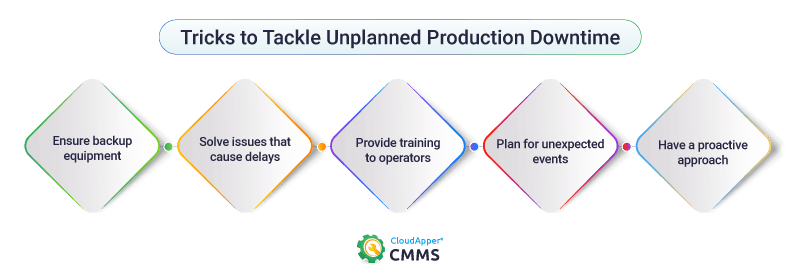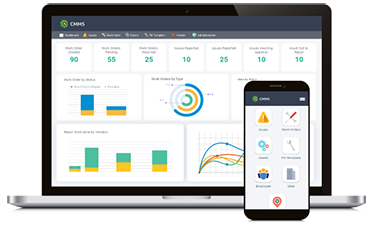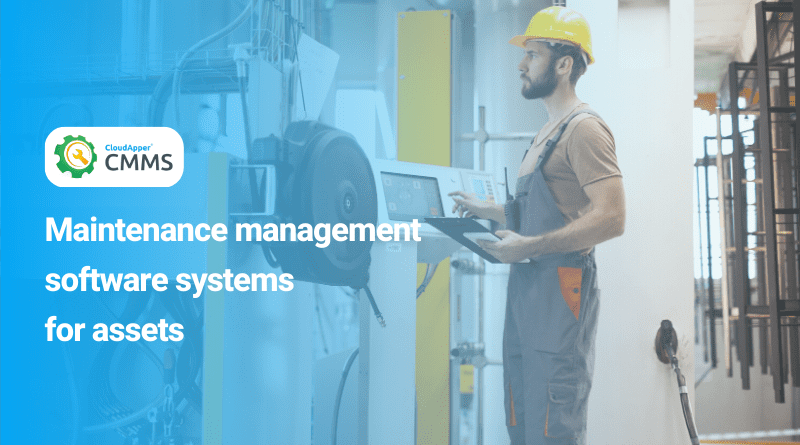Table of Contents
We’ve already talked about how problematic unplanned production downtime can be for manufacturing organizations. It leads to wasted resources, production disruptions, lower units produced, and losses, among other drawbacks. While there are various reasons why unplanned downtime in production occurs, most of the time, the culprit is malfunctioning machinery or equipment breakdown.
Fortunately, some hacks help reduce machine downtime, and this is a continuation of the same topic. That being said, let’s take a look at a few more tricks that maintenance teams can use to reduce unplanned downtime in production facilities.
Five more tricks to tackle unplanned downtime in production facilities
Purchase backup equipment for critical processes
Every manufacturing facility has some pieces of equipment which are critical for production. If any machinery fails or malfunctions, it’ll lead to a massive bottleneck in the production process and cause an enormous setback for the manufacturing goals. As a result, having backup equipment on hand can significantly reduce production downtime. While having backups of all the equipment is costly and unfeasible, having a backup for the most crucial ones can save organizations from huge setbacks as they can always keep production running.

Solve issues that cause delays
We’ve already mentioned that there are various reasons for unplanned downtime in production facilities. While we’ve mostly talked about failing machinery, organizations need to be on the lookout for other reasons as well. For instance, organizations can optimize production processes by identifying inefficient steps and working on them.
Suppose machine operators don’t know how to start up a centrifuge – because only their supervisor has been trained to do that. This might lead to delays as the supervisor might be busy with another task, is in another plant, or is absent, leading to production disruptions. Instead of relying on their supervisor, the process can be printed and attached to the equipment or digitally provided to the operators via the maintenance solution they use – reducing production downtime.
Organizations can also automate repetitive tasks, change the floor layout to reduce redundant steps, or attach barcodes to the pieces of equipment to improve efficiency and reduce delays (to submit work orders or check part inventory).
Provide safety training to operators
While training machine operators on how to operate the machinery is essential, something that’s even more crucial is to provide safety training. Even the smallest mistake can be catastrophic for both the operator and anyone in the vicinity, and while it puts everyone at risk, it also adds to unplanned downtime. As a result, providing operators with safety training is a must.
Provide the operators with safety training regarding the most current practices, the most recent accidents in the industry, the dos and don’ts, and test their knowledge via interviews, written tests, or with the equipment in a controlled environment. Not only does it help reduce workplace incidents, but it also ensures that the equipment is being operated properly, reducing machine downtime and even guaranteeing compliance with the industry’s safety regulations.
Plan for the unexpected
Equipment maintenance is a fickle thing – one can’t predict what may happen, even with robust preventive maintenance planning. Even the best equipment might fail suddenly, spare parts might not be available, or the manufacturer could recall the most recently purchased equipment. Organizations need to include these uncertainties in their preventive maintenance plans and outline strategies so that production can continue. Although, no amount of planning can ensure that the organization won’t feel the effects of such events; planning for them beforehand can help mitigate a portion of downtime and its resulting losses.

Be proactive
This one is a standard tip for reducing downtime in production but is still an underused and underrated practice. Maintenance management isn’t a task; it’s a continuous process as potential problems are always on the horizon. Thus, maintenance managers must always be on the lookout for these problems rather than waiting for emergency work requests. For instance, they can look at the work order history, the pieces of equipment that malfunction the most, and assign staff to deal with the problems as required. Moreover, they can choose to go to the root cause of the issues to solve the problem permanently. All of this, and so much more, can be effectively managed with CloudApper CMMS.
CloudApper CMMS reduces downtime in production facilities
CloudApper CMMS is an affordable, reliable and customizable CMMS software solution that provides more for less. While it comes with all the perks of other CMMS software solutions such as asset management, spare parts & inventory management, analytics dashboard, vendor management, technician management, and so much more, also, users can customize it from the ground up. In addition, CloudApper CMMS makes maintenance management easy, streamlines asset repairs, and ensures preventive maintenance on the go – because maintenance teams can use it from smartphones and tablets.
CloudApper CMMS is built using CloudApper, a no-code platform for enterprise mobile app development, which is highly affordable at only $10/user/month. The best part is that it also provides access to the CloudApper marketplace – which houses hundreds of other enterprise applications that organizations can use to digitize their processes and operate their businesses on the go.
Contact us now and reduce production downtime, minimize costs, and improve asset longevity using your smartphone.
What is CloudApper AI Platform?
CloudApper AI is an advanced platform that enables organizations to integrate AI into their existing enterprise systems effortlessly, without the need for technical expertise, costly development, or upgrading the underlying infrastructure. By transforming legacy systems into AI-capable solutions, CloudApper allows companies to harness the power of Generative AI quickly and efficiently. This approach has been successfully implemented with leading systems like UKG, Workday, Oracle, Paradox, Amazon AWS Bedrock and can be applied across various industries, helping businesses enhance productivity, automate processes, and gain deeper insights without the usual complexities. With CloudApper AI, you can start experiencing the transformative benefits of AI today. Learn More

















